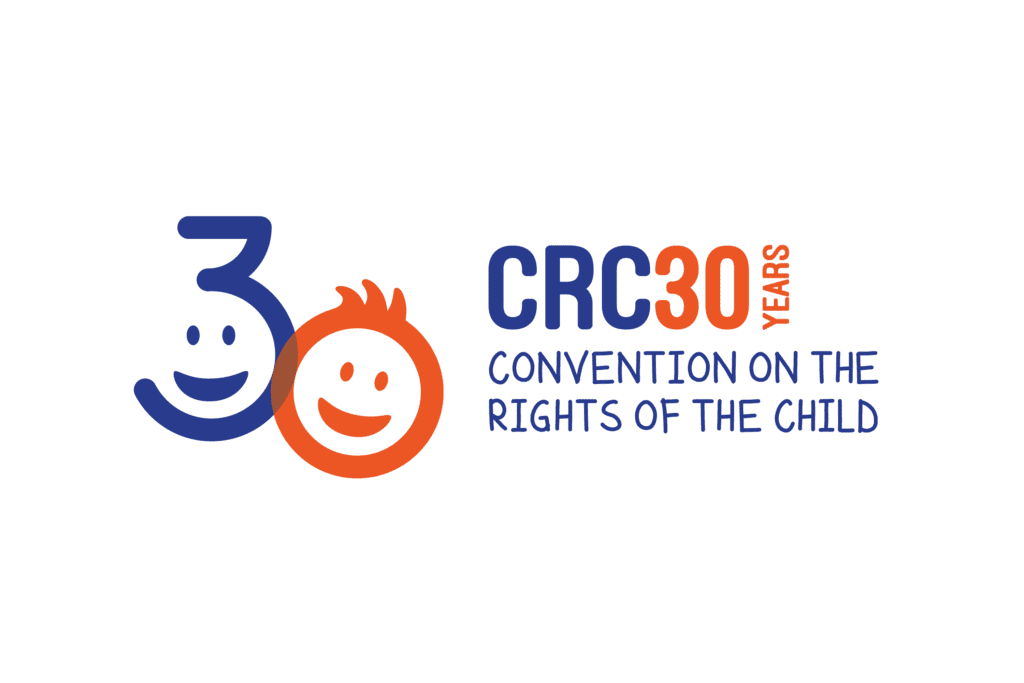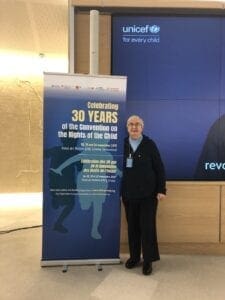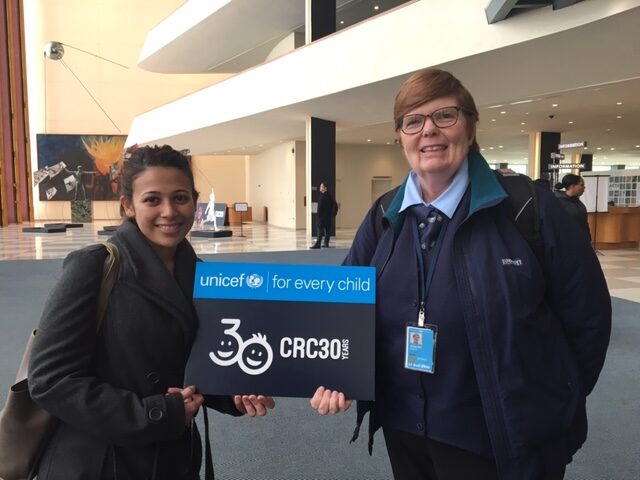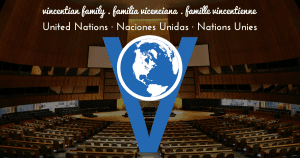
On November 21, Sr. Theresa Kotturan, SCN, gave us wonderful insight into the 30th anniversary of the Convention on the Rights of the Child and its links to concerns such as poverty, hunger, education, and migration. This week, I’d like to share how the important anniversary was honoured in Geneva.
 Last week was very busy with the 30th Anniversary of the Convention on the Rights of the Child (CRC) being commemorated through a three-day event in Geneva. Many good things have been remembered, but it is evident from these celebrations that so much more remains to be done.
Last week was very busy with the 30th Anniversary of the Convention on the Rights of the Child (CRC) being commemorated through a three-day event in Geneva. Many good things have been remembered, but it is evident from these celebrations that so much more remains to be done.
Sr. Monica Cowman, an Irish sister who has passed on, was a master champion of the Rights of the Child. I remember her efforts all those years ago. She is a fitting reminder of how we stand on the shoulders of those who come before us and how we pave the way for those who come after us.
As I participated in the CRC celebrations in Geneva, I was conscious of the work of the Vincentian Family to end homelessness. Child homelessness in particular is an enormous subset of homelessness overall. UNICEF reports there are about 28 million children without homes globally due to violent conflict alone. Another commonly quoted figure is that there are more than 100 million street children globally. However, accurate statistics are difficult to access. As the Working Group to End Homelessness prepares for the Commission on Social Development next January, let us join our voices in the work to end all forms of homelessness.
- NOW THROUGH DECEMBER 10: ORANGE THE WORLD:: Wear orange to symbolize the importance of ending violence against women.
- DECEMBER 1: World AIDS Day
- DECEMBER 2: International Day for the Abolition of Slavery
- DECEMBER 3: International Day of Persons With Disabilities
- DECEMBER 5: International Day for Economic and Social Development
The Convention on the Rights of the Child (CRC) was adopted and opened for signature, ratification and accession by General Assembly resolution 44/24, on 20 November, 1989. Today, the CRC is the most ratified international treaty. In total, 196 State parties have ratified it, with the United States of America being the only State not to have done so.
The CRC lays out the civil, political, economic, social and cultural rights of every child, which apply regardless of a child’s race, religion or abilities, along with three optional protocols. It was a landmark instrument in 1989 as for the first time, a document existed which enumerated children as rights holders in and of themselves. You can access the full Convention below, as well as the child friendly version created by UNICEF and Child Rights Connect.
To celebrate 30 years of the CRC in Geneva, a comprehensive program featuring the pertinent topics impacting the realisation of children’s rights was arranged. Perhaps the only downside of the event was that sessions were held parallel to each other, meaning that I had to choose which to attend – it was a difficult choice to say the least!
Arigatou International’s session on a multi-religious study on the CRC unveiled some interesting key findings. The study, commissioned specifically for this event, found that the core values of the seven religions considered were reflected in each other and in the CRC itself. Knowledge about this commonality was also revealed to be lacking among religious leaders and groups. The study encouraged religious leaders to therefore use the CRC to influence their own outreach as well as engage in multi-religious dialogues and interaction to promote the aims of the convention, as well as societal peace and stability.

The session on child protection explored many subtopics including all forms of child abuse and exploitation, digital safety, and alternative care institutions. All panellists called for greater funding and research for organisations involved in child protection to ensure that the provision of services is evidenced-based, with highly trained professionals placing the best interests of the child at the centre of programs. The overwhelming message was that child protection is the obligation of everyone, not just those who have elected to work in this area.
Another session of interest was titled ‘Migration and Children’s Rights’. During this session, five unaccompanied asylum seeker children aged 14 – 18, appeared via video link. During the presentation of their experiences, they chose to wear masks in order to preserve their anonymity, as they were certain their participation would impact poorly on their asylum application. The five explained how in Switzerland they were migrants first and children second. This distinction restricted their access to education, health and social services – such facilities automatically provided to non-migrant children . Indeed, one explained how his permit allowed him to receive only CHF 10 (Swiss francs) per day and when he was unable to find somewhere to sleep at night, he was simply provided with a sleeping bag.
Such migration policies, which are reflected throughout Europe and beyond, compound the homelessness crisis and continue the cycle of disadvantage and inequality. With rising protracted conflicts, mass movement due to climate change, and increasing numbers of internally displaced people, homelessness and, in particular, youth homelessness, is going to be an ongoing challenge for our Vincentian Family to address.
 As well as dedicated sessions, the event hosted many exhibitions and launched several reports. The exhibition, ‘Drawings of gods,’ presented the artwork of children who were asked to simply draw what ‘God’ meant to them. The launch of the ‘Global Study on Children Deprived of Liberty’ provided an insight into the closed doors of child detention and forced participants to consider the necessity of such action. The Holy See released its report on the right to education, ‘ Education as a Driver to Integral Growth and Peace.’ Finally, States were given the opportunity to recommit to the CRC by submitting updated pledges.
As well as dedicated sessions, the event hosted many exhibitions and launched several reports. The exhibition, ‘Drawings of gods,’ presented the artwork of children who were asked to simply draw what ‘God’ meant to them. The launch of the ‘Global Study on Children Deprived of Liberty’ provided an insight into the closed doors of child detention and forced participants to consider the necessity of such action. The Holy See released its report on the right to education, ‘ Education as a Driver to Integral Growth and Peace.’ Finally, States were given the opportunity to recommit to the CRC by submitting updated pledges.
During the event, child participants emphasised that policies and procedures should not be made about them, without them. Children are actors capable of enforcing their own rights and using their resources to amplify their voice, if given space which is meaningful, inclusive, and safe. Nowhere is this more apparent than in the ongoing campaign for climate action where the lead advocate is a sixteen-year-old girl. Children want their rights to be viewed first and foremost as human rights, and for these rights to be respected and afforded protection.
For a commemorative conference where children were at the forefront hosting sessions, asking question, presenting and critically thinking, I’m inspired by what the next 30 years of the CRC will bring. There will be challenges but with the enthusiasm and passion exhibited by young people today who are fighting to be considered now, I am confident that only success lies ahead.
Links:
For the full Convention on the Rights of the Child, click here
For the UNICEF-Child Rights Connect child friendly version for English, French, Spanish, Russian, Arabic, and Chinese.
For the Executive Summary and full study of Arigatou International’s ‘Faith and Children’s Rights: A Multi-religious Study on the Convention on the Rights of the Child’, click here.
For the full report of ‘Education as a Driver to Integral Growth and Peace’ by the Holy See, click here.
For information on the exhibition, ‘Drawings of gods,’ click here.
To access the General Assembly’s report on the Global Study on Children Deprived of Liberty, click here. You can also watch the press conference here.
To watch António Gueterres, Secretary General of the United Nations, deliver a video message on the 30th Anniversary of the Convention of the Rights of the Child, click here.
For the full list of State pledges, click here.








0 Comments